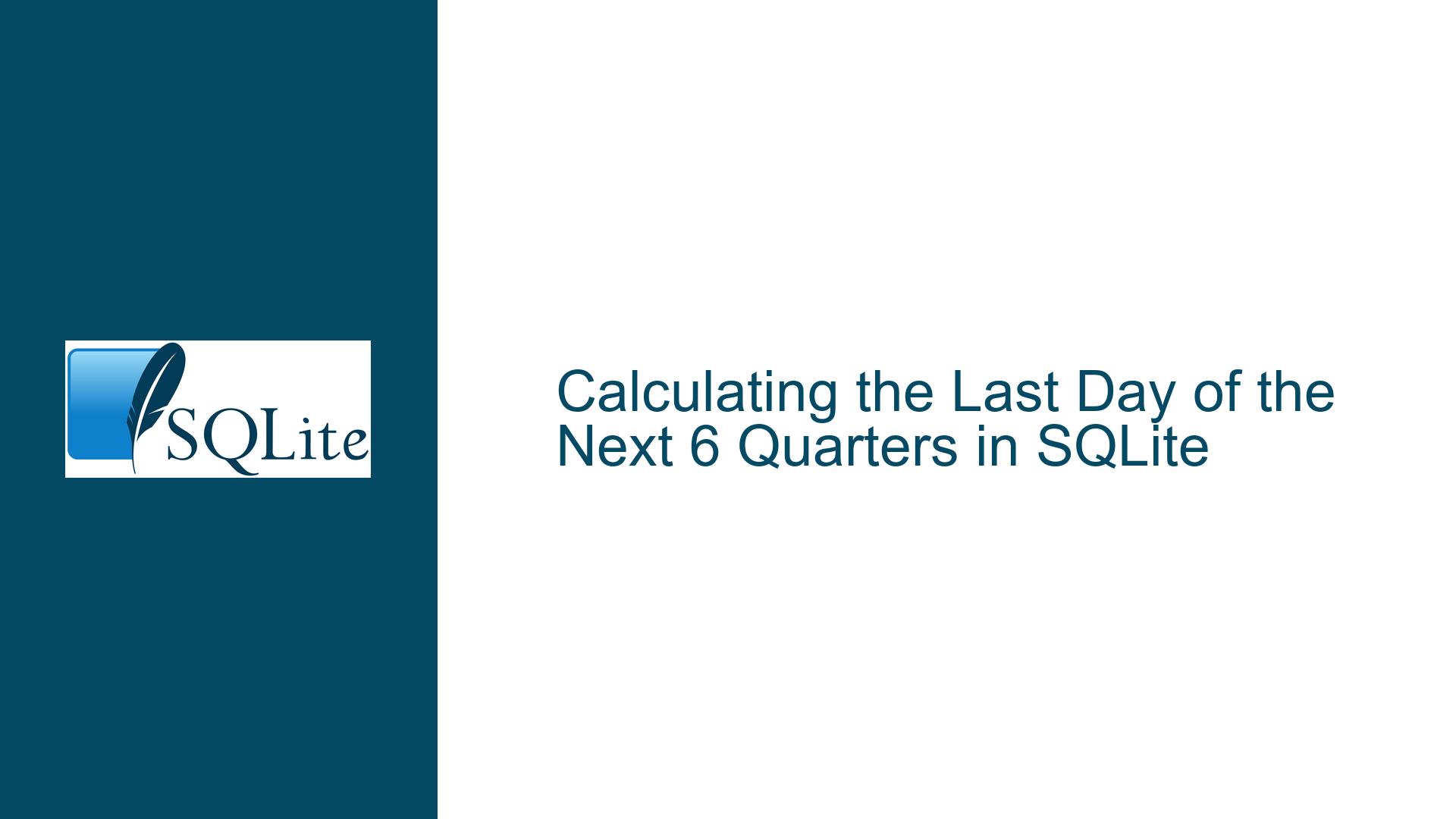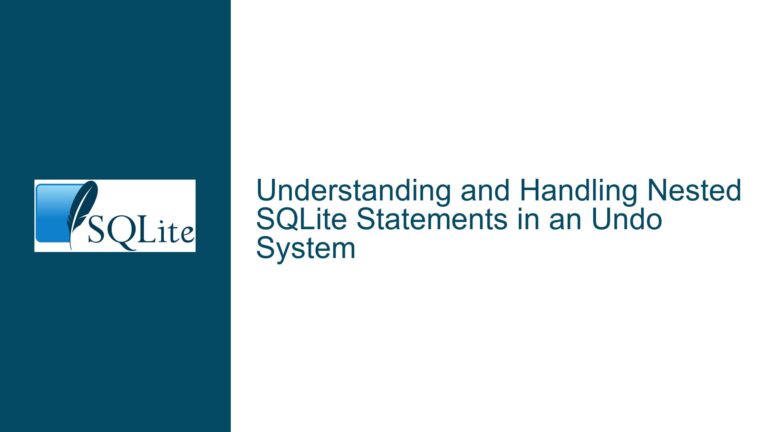Calculating the Last Day of the Next 6 Quarters in SQLite
Understanding the Problem: Computing Quarter-End Dates in SQLite
The core issue revolves around calculating the last day of the next six quarters in SQLite. SQLite’s date() function provides a robust set of date manipulation capabilities, but it lacks a direct "start of quarter" modifier. This limitation complicates the task of determining quarter-end dates, especially when working with dynamic date ranges. The challenge is to derive a solution that accurately computes the last day of each quarter for the next six quarters, accounting for the nuances of SQLite’s date and time functions.
The problem is further compounded by the need to handle edge cases, such as the transition between years and the correct calculation of quarter boundaries. For instance, the last day of the first quarter (Q1) is March 31, the second quarter (Q2) ends on June 30, and so on. However, SQLite does not natively support quarter-based calculations, requiring a workaround using existing date functions and arithmetic operations.
The solution must also consider the potential impact of time zones, as SQLite’s date('now') function returns UTC time. If the application requires local time accuracy, additional steps are necessary to convert UTC to the local time zone. This adds another layer of complexity to the problem, as the accuracy of the quarter-end dates depends on the correct handling of time zone differences.
Exploring the Causes: Why SQLite Lacks Native Quarter Support
The absence of a native "start of quarter" modifier in SQLite’s date() function is the primary cause of the difficulty in computing quarter-end dates. SQLite’s date and time functions are designed to be lightweight and efficient, prioritizing simplicity over extensive feature sets. While this design philosophy makes SQLite highly performant and easy to embed in applications, it also means that certain advanced date manipulation features, such as quarter-based calculations, are not included.
Another contributing factor is the variability in how quarters are defined across different contexts. For example, some organizations define their fiscal quarters differently from calendar quarters, which can further complicate the calculation of quarter-end dates. SQLite’s date functions do not account for such variations, requiring users to implement custom logic to handle these cases.
The reliance on string manipulation and arithmetic operations to derive quarter-end dates also introduces potential sources of error. For instance, incorrect integer division or improper handling of month-to-quarter mappings can lead to inaccurate results. Additionally, the need to convert between different data types (e.g., strings to integers) adds complexity and increases the risk of bugs in the implementation.
Time zone considerations further exacerbate the issue. SQLite’s date('now') function returns the current date and time in UTC, which may not align with the local time zone of the application. If the application requires local time accuracy, additional steps are needed to convert UTC to the local time zone. This introduces another layer of complexity, as the accuracy of the quarter-end dates depends on the correct handling of time zone differences.
Crafting the Solution: Step-by-Step Guide to Calculating Quarter-End Dates
To address the problem of computing the last day of the next six quarters in SQLite, we can leverage a combination of SQLite’s date functions, arithmetic operations, and recursive common table expressions (CTEs). The following steps outline a robust solution that accounts for the nuances of SQLite’s date handling and ensures accurate results.
Step 1: Determine the Current Quarter
The first step is to determine the current quarter based on the current month. This can be achieved using the strftime('%m') function, which extracts the month number from the current date. The formula (strftime('%m') + 2) / 3 maps the month number to the corresponding quarter. For example, January (month 1) maps to quarter 1, April (month 4) maps to quarter 2, and so on.
Step 2: Calculate the End Date of the Current Quarter
Once the current quarter is determined, the next step is to calculate the end date of the current quarter. This can be done by using the date() function with the start of year modifier and adding the appropriate number of months to reach the end of the quarter. For example, to calculate the end date of Q1, we add 3 months to the start of the year and subtract 1 day to get March 31.
Step 3: Use a Recursive CTE to Generate Future Quarters
To generate the end dates for the next six quarters, we can use a recursive CTE. The CTE starts with the current quarter and its end date, then iteratively calculates the end dates of subsequent quarters by incrementing the quarter number and adding 3 months to the previous end date. The LIMIT clause ensures that the CTE stops after generating six quarters.
Step 4: Handle Time Zone Differences
If the application requires local time accuracy, additional steps are needed to convert UTC to the local time zone. This can be achieved using the datetime() function with the localtime modifier. For example, datetime('now', 'localtime') returns the current date and time in the local time zone. This ensures that the quarter-end dates are calculated based on the local time zone, rather than UTC.
Step 5: Implement the Final Query
The final query combines all the steps into a single SQL statement. The query uses a recursive CTE to generate the end dates for the next six quarters, ensuring accurate results even when transitioning between years. The LIMIT clause is placed at the end of the query to control the number of quarters generated.
Here is the complete SQL query:
WITH quarters AS (
SELECT (strftime('%m', 'now', 'localtime') + 2) / 3 AS quarter,
date('now', 'start of year', printf('%d months', ((strftime('%m', 'now', 'localtime') + 2) / 3) * 3), '-1 day') AS end_date
UNION ALL
SELECT quarter + 1,
date('now', 'start of year', printf('%d months', (quarter + 1) * 3), '-1 day') AS end_date
FROM quarters
LIMIT 6
)
SELECT quarter, end_date FROM quarters;
This query produces the following output:
┌─────────┬────────────┐
│ quarter │ end_date │
├─────────┼────────────┤
│ 1 │ 2024-03-31 │
│ 2 │ 2024-06-30 │
│ 3 │ 2024-09-30 │
│ 4 │ 2024-12-31 │
│ 5 │ 2025-03-31 │
│ 6 │ 2025-06-30 │
└─────────┴────────────┘
By following these steps, we can accurately compute the last day of the next six quarters in SQLite, even in the absence of a native "start of quarter" modifier. This solution is robust, efficient, and adaptable to various use cases, making it a valuable tool for database developers working with SQLite.






